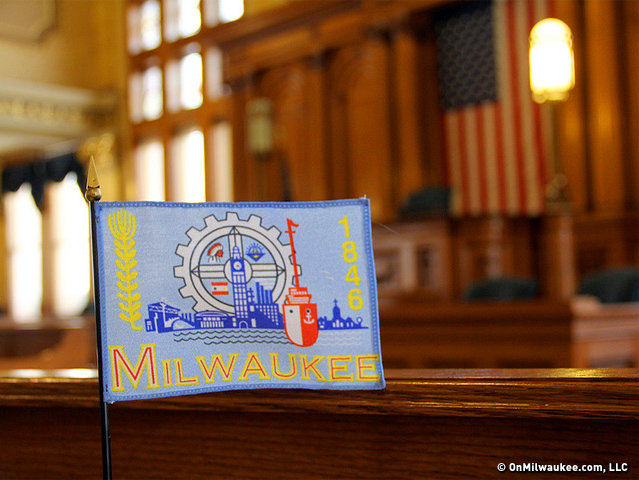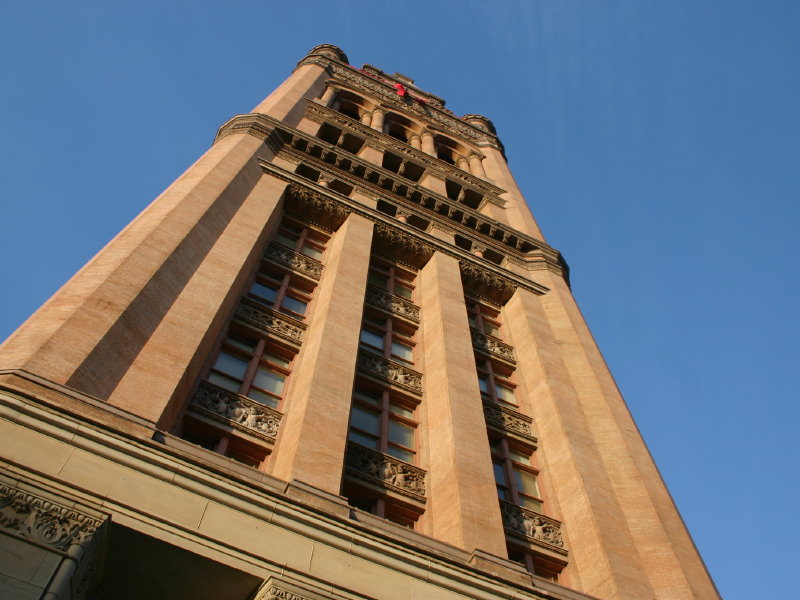 Walking
through Milwaukee's City Hall's lobby, footsteps reverberate across the same
tiles that thousands have tread upon before. Strolling through, you can almost
see men with handlebar moustaches laughing heartily. They fade away as men
dressed in three-piece suits and fedoras pass by with a powerful stride. Soon,
those men evolve to those clad in the jeans and t-shirt uniform of present.
Walking
through Milwaukee's City Hall's lobby, footsteps reverberate across the same
tiles that thousands have tread upon before. Strolling through, you can almost
see men with handlebar moustaches laughing heartily. They fade away as men
dressed in three-piece suits and fedoras pass by with a powerful stride. Soon,
those men evolve to those clad in the jeans and t-shirt uniform of present.
City
Hall is timeless. Its atmosphere of is one of quiet sophistication, steady, unwavering. Gazing around, it is impossible to miss
the history enclosed within it. For more than 100 years, citizens have
come inside to vote, obtain permits and licenses or to escape the elements. And
while the beauty and stateliness of City Hall speak for themselves, its story
is important to Milwaukee's heritage.
Throughout its life, City
Hall has seen construction complications and concerns, mostly due to the desire
to maintain an exciting and evolving image of Milwaukee. The most concern was
caused in the late '20s and early '30s when reconstruction was scheduled after an
electrical fire destroyed parts of the clock tower. Attempts to create a more
modern and art deco tower, to follow the architecture trends of the time, were
met with argumentative animosity. One plan called for the lopping off of the structure
from the clock up and replacing it with enclosed glass and a revolving beacon
to prevent low-flying aircraft from colliding with the structure. These ideas
were tossed aside as city officials opted for the more traditional look to remain
dominating Milwaukee's skyline.
{INSERT_RELATED}
City Hall's interior has remained virtually
unchanged since first designed. As a governmental building, it is functional and
practical. As a picture of architectural beauty, it remains unsurpassed. Thousands
of mosaic tiles create the floor and the stories stretch above those on the ground
floor in an image of rapid repetition. One after the other, in a blur of brass
railings and wood banisters, balconies tower over those gazing up from the ground
level. The atrium provides light and air circulation for the building while
also providing an architecturally stunning environment.
The view from
the eighth floor provides an almost sickeningly birds-eye view of the building.
Looking down into the open well, you have an unobstructed view to the ground level
and the tiled cement floor hundreds of feet below. The clear view to the bottom was
a source of controversy and concern in the '30s, as eight people committed
suicide from 1928-'40. Officials took preventative measures to protect potential
jumpers as well as those on the first floor. Brass barricades were erected to
prevent the downtrodden from ending their lives. In 1988, officials removed the
barricades to enhance and restore the structures original beauty.
Mayor
Norquist has continued the trend to keep City Hall in original condition
throughout his tenure. Along with the removal of the barricades from the upper
floors, the city also took down the welcome sign on the building's south side
in 1988. The sign, used to promote city celebrations and occasions and immortalized in television's "Laverne & Shirley," was affixed
to the exterior in 1906. Crews worked to change the sign's message sometimes as
often as three times daily, depending on events in Milwaukee.
The most recent event in City Hall's history began just recently as we flipped
our calendars from 1999 to 2000, when the City Hall
bell, named Solomon Juneau, began to peal again. January 1 it also welcomed Milwaukee's largest bell back to work. Daily
at 8 a.m., noon and 5 p.m., the City Hall bell tolls. Rumor was that Mayor Daniel Hoan was bothered by headaches caused by the
tolling, but the truth is that the vibrations were rocking the building's foundations, causing damage.
The bell remained silent for 75 years.
While the bell tower projects
majestically skyward alongside Milwaukee's more modern structures, the history within its walls illustrate there's more behind a building besides brick
and mortar.







